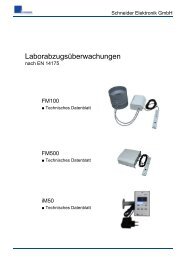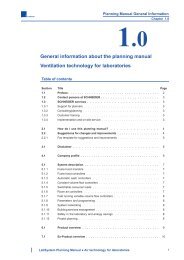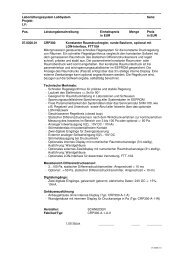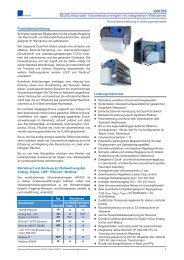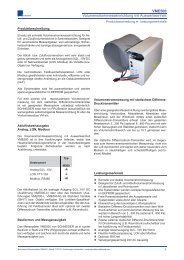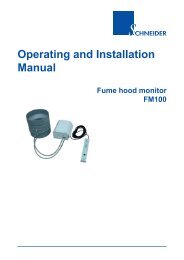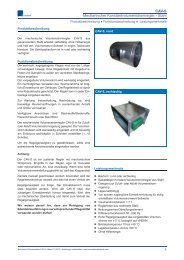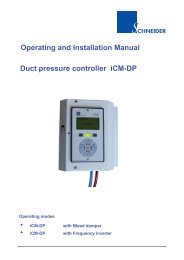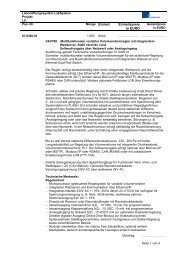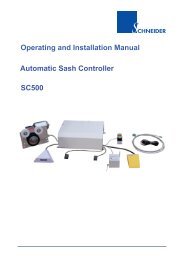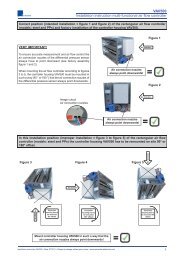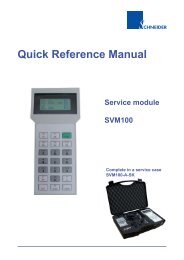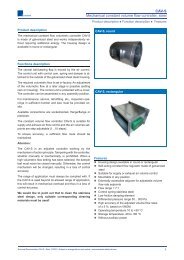Operating and Installation Manual iM50 Fume hood monitor face ...
Operating and Installation Manual iM50 Fume hood monitor face ...
Operating and Installation Manual iM50 Fume hood monitor face ...
Create successful ePaper yourself
Turn your PDF publications into a flip-book with our unique Google optimized e-Paper software.
<strong>Operating</strong> <strong>and</strong> <strong>Installation</strong> <strong>Manual</strong><br />
<strong>iM50</strong><br />
<strong>Fume</strong> <strong>hood</strong> <strong>monitor</strong> <strong>face</strong> velocity
SCHNEIDER Elektronik GmbH Phone: +49 (0) 6171 / 88 479 - 0<br />
Fax: +49 (0) 6171 / 88 479 - 99<br />
Industriestraße 4 e-mail: info@schneider-elektronik.de<br />
61449 Steinbach • Germany www.schneider-elektronik.com
DECLARATION OF CONFORMITY<br />
DECLARATION OF CONFORMITY<br />
SCHNEIDER Elektronik GmbH hereby declares that the device:<br />
FUME HOOD MONITOR <strong>iM50</strong><br />
complies with the basic requirements of the European Council Directive for<br />
electromagnetic compatibility (89/336/EEC) <strong>and</strong> the CE Marking Directive<br />
(93/68/EEC).<br />
You may request a copy of the declaration of conformity at the address given<br />
below.<br />
SCHNEIDER Elektronik GmbH<br />
Industriestraße 4<br />
61449 Steinbach<br />
Tel.: +49 (0) 6171 / 88 479 - 0<br />
Fax: +49 (0) 6171 / 88 479 - 99<br />
e-mail: info@schneider-elektronik.de<br />
www.schneider-elektronik.de<br />
© 2009 SCHNEIDER Elektronik GmbH<br />
61449 Steinbach ● Germany<br />
Translation, reproduction <strong>and</strong> other uses, etc. - in whole or in part - are only<br />
allowed with the explicit permission of Schneider Elektronik GmbH.<br />
In the course of continuous product improvements we reserve the right to<br />
make technical <strong>and</strong> <strong>and</strong> design changes.<br />
All rights reserved.<br />
Date: 12/2009<br />
<strong>Operating</strong> manual ● <strong>iM50</strong><br />
1
SAFETY INSTRUCTIONS<br />
1.0 SAFETY INSTRUCTIONS<br />
Before installing <strong>and</strong> using the <strong>iM50</strong> fume <strong>hood</strong> <strong>monitor</strong>, please read <strong>and</strong><br />
follow this operating <strong>and</strong> installation manual carefully.<br />
• <strong>Installation</strong> <strong>and</strong> wiring may only be done by qualifi ed specialists.<br />
• Check whether the operating voltage shown on the nameplate corresponds<br />
with the supply voltage at the site where the device will be installed.<br />
• During installation, wiring <strong>and</strong> operation, recognised technical precepts,<br />
particularly regulations regarding safety <strong>and</strong> accident prevention,<br />
must be followed.<br />
• The device should only be returned to the manfacturer for repair in the<br />
original box.<br />
• When you see the symbol CAUTION, we<br />
recommend that you pay careful attention<br />
to the explanatory text <strong>and</strong> notes.<br />
ELECTRICAL CONNECTION<br />
• The electrical connection must be done by a qualifi ed electrician in<br />
accordance with the safety precautions.<br />
• The following rules <strong>and</strong> regulations must be followed:<br />
VDE guidelines<br />
Local power supplier regulations<br />
Manufacturer wiring instructions <strong>and</strong> terminal connection<br />
diagrams<br />
• Connect the <strong>iM50</strong> fume <strong>hood</strong> <strong>monitor</strong> to its own, separate circuit to protect<br />
against overload.<br />
• Do not do any electrical work on the device when the power supply<br />
is switched on.<br />
• Follow the safety regulations at all times:<br />
- Disconnect the <strong>iM50</strong> fume <strong>hood</strong> <strong>monitor</strong><br />
- Ensure that the fume <strong>hood</strong> <strong>monitor</strong> cannot be switched<br />
on again<br />
- Ensure that the fume <strong>hood</strong> <strong>monitor</strong> is voltage-free<br />
OPERATING SAFETY<br />
• Do not use the <strong>iM50</strong> device immediately after bringing it from<br />
an unheated room into a warm room. Condensation on<br />
the electronic circuits can lead to severe damage. The device reaches<br />
room temperature after approximately 2 hours.<br />
• Always pull the mains plug or disconnect the device from the power<br />
if objects or fl uids have permeated the device or if you notice a smell or<br />
smoke. Have the manufacturer check the device.<br />
• Always pull the mains plug or disconnect the device from the power<br />
supply if the case or lid of the device has to be opened.<br />
PROPER<br />
USE<br />
• The <strong>iM50</strong> fume <strong>hood</strong> <strong>monitor</strong> is intended solely for controlling <strong>and</strong><br />
<strong>monitor</strong>ing volume fl ows in fume <strong>hood</strong>s in accordance with EN 14175, Part 2.<br />
• Do not use the <strong>iM50</strong> fume <strong>hood</strong> <strong>monitor</strong> in areas that are vulnerable to<br />
explosion.<br />
CE-NOTE<br />
The <strong>iM50</strong> fume <strong>hood</strong> <strong>monitor</strong> complies with the safety requirements of the EMC<br />
law <strong>and</strong> the CE Marking Directive <strong>and</strong> therefore disposes of a CE Marking.<br />
2 <strong>Operating</strong> manual ● <strong>iM50</strong>
TABLE OF CONTENTS<br />
TABLE OF CONTENTS 1.1<br />
Page<br />
DECLARATION OF CONFORMITY . . . . . . . . . . . . . . . . . . 1<br />
1.0 SAFETY INSTRUCTIONS . . . . . . . . . . . . . . . . . . . . . . . . 2<br />
1.1 TABLE OF CONTENTS . . . . . . . . . . . . . . . . . . . . . . . . . 3<br />
2.0 FUNCTIONAL DESCRIPTION . . . . . . . . . . . . . . . . . . . . . 4<br />
2.1 FUNCTION DISPLAY AND CONTROL PANEL . . . . . . . . . . . . 4<br />
2.2 FUNCTIONAL DIAGRAM FACE VELOCITY . . . . . . . . . . . . . . . . 5<br />
2.3 PERFORMANCE FEATURES . . . . . . . . . . . . . . . . . . . . . . . . 5<br />
3.0 OPERATING MODE FACE VELOCITY MONITORING . . . . . . . . 6<br />
4.0 SCOPE OF DELIVERY . . . . . . . . . . . . . . . . . . . . . . . . . . . . 6<br />
5.0 TERMINAL DIAGRAM . . . . . . . . . . . . . . . . . . . . . . . . . . . . . 7<br />
6.0 INSTALLATION • THE FIRST THREE STEPS. . . . . . . . . 8<br />
6.1 STEP 1 • FITTING THE MONITOR . . . . . . . . . . . . . . . . . . . . . . 8<br />
6.2 STEP 2 • MOUNTING THE CONNECTING PIPE . . . . . . . . . . . . . 8<br />
6.3 STEP 4 • POWER SUPPLY. . . . . . . . . . . . . . . . . . . . . . . 9<br />
7.0 CONNECTING ADDITIONAL FUNCTIONS . . . . . . . . . . . . . . 10<br />
7.1 CONNECTING THE RELAY OUTPUTS . . . . . . . . . . . . . . . . . 10<br />
7.1.1 CONNECTING THE RELAY CONTACT LIGHT K1 . . . . . . . . . . . . . 10<br />
7.1.2 CONNECTING THE RELAY CONTACT ALARM K2 . . . . . . . . 11<br />
7.1.3 CONNECTING THE RELAY CONTACT MOTOR ON/OFF K3 . . . . . . . . 11<br />
7.2 CONNECTING THE DIGITAL INPUT SASH > 50 cm. . . . . . . . . . . . 12<br />
7.3 CONNECTING THE DIGITAL INPUT DAY/NIGHT . . . . . . . . . . 12<br />
7.4 CONNECTING THE ANALOGUE OUTPUT . . . . . . . . . . . . . . . 13<br />
7.5 CONNECTING THE SERIAL INTERFACE RS232 . . . . . . . . . . . . 13<br />
7.6 CONNECTING THE ANALOGUE INPUT . . . . . . . . . . . . . . . . . . 13<br />
8.0 FUNCTION DISPLAY AND CONTROL PANEL . . . . . . . . . . . . . . 14<br />
9.0 PROGRAMMING INSTRUCTIONS VIA INTERNAL SYSTEM LEVEL . 16<br />
9.1.1 FACE VELOCITY NIGHT-TIME OPERATION . . . . . . . . . . . . . . 17<br />
9.1.2 FACE VELOCITY DAYTIME OPERATION . . . . . . . . . . . . . . . . 17<br />
9.2.1 ALARM DELAY TIME . . . . . . . . . . . . . . . . . . . . . . . . . . . 18<br />
9.2.2 DELAY OF THE INPUTS AND SWITCH TYPE DEFINITION . . . . . . 18<br />
9.2.2.1 SENSOR ATTENUATION . . . . . . . . . . . . . . . . . . . . . . . . . . . 19<br />
9.2.2.2 ALARM DELAY AFTER START-UP . . . . . . . . . . . . . . . . . . . . . 19<br />
9.2.2.3 CONTACT INVERSION MALFUNCTION NOTIFICATION RELAY . . . 20<br />
9.2.2.4 SWITCH TYPE "SASH > 50 CM" . . . . . . . . . . . . . . . . . . . . . . 20<br />
9.2.2.5 SWITCH TYPE DAY/NIGHT . . . . . . . . . . . . . . . . . . . . . . . 20<br />
9.3 CALIBRATION OF THE SENSOR . . . . . . . . . . . . . . . . . . . . . 21<br />
9.4 SETTINGS ON DELIVERY 21<br />
10.0 <strong>iM50</strong> TROUBLESHOOTING ERRORS . . . . . . . . . . . . . . . . . . . . 22<br />
11.0 <strong>iM50</strong> TROUBLESHOOTING MALFUNCTIONS . . . . . . . . . . . . . . 24<br />
12.0 MAINTENANCE . . . . . . . . . . . . . . . . . . . . . . . . . . . . . . . 25<br />
12.1 ANNUAL FUME HOOD MAINTENANCE . . . . . . . . . . . . . . . . . . 25<br />
13.0 TECHNICAL DATA . . . . . . . . . . . . . . . . . . . . . . . . . . 26<br />
14.0 DIMENSIONS AND DIMENSIONAL DIAGRAMS . . . . . . . . . . . . . 27<br />
15.0 INDEX . . . . . . . . . . . . . . . . . . . . . . . . . . . . . . . . . 28<br />
<strong>Operating</strong> manual ● <strong>iM50</strong><br />
3
FUNCTIONAL DESCRIPTION<br />
2.0 FUNCTIONAL DESCRIPTION<br />
For use as a <strong>monitor</strong>ing <strong>and</strong> alarm system for <strong>face</strong> velocities in various<br />
applications, such as fume <strong>hood</strong>s, safety cabinets <strong>and</strong> other extraction units.<br />
Microprocessor controlled security system with integrated air fl ow sensor for<br />
<strong>monitor</strong>ing the containment-safe operating status of fume <strong>hood</strong>s. An acoustic<br />
<strong>and</strong> optical alarm is activated as soon as the <strong>face</strong> velocity falls below the<br />
programmed threshold value.<br />
The <strong>iM50</strong> Airfl ow Monitor fulfi lls the EN 14175 st<strong>and</strong>ard. That means safety for<br />
the laboratory worker. <strong>iM50</strong> is suitable for all types of fume <strong>hood</strong>, making it easy<br />
to implement new installations <strong>and</strong> retrofi t existing fume <strong>hood</strong>s. <strong>Installation</strong> is<br />
very easy <strong>and</strong> is done directly on the side bar (pilaster) of the fume <strong>hood</strong>. The<br />
<strong>face</strong> velocity in the fume <strong>hood</strong> is identical to the <strong>face</strong> velocity measured in the<br />
bypass with the integrated air fl ow sensor of the <strong>iM50</strong> Airfl ow Monitor.<br />
The <strong>face</strong> velocity is also displayed via an LED bar graph, so it is possible to<br />
directly read off the actual value in m/s und ft/min.<br />
The red LED, together with an acoustic alarm, signals the alarm operating<br />
status (insuffi cient <strong>face</strong> velocity). The green LED signals the safe operating<br />
status (<strong>face</strong> velocity is OK). The yellow LED signals the status "Sash > 50 cm"<br />
(only with an additional switch provided by the customer).<br />
2.1 FUNCTION DISPLAY<br />
AND CONTROL PANEL<br />
airflow <strong>monitor</strong><br />
0<br />
0<br />
<strong>iM50</strong><br />
0.3 0.5 0.7 1.0 m/s<br />
60 100 140 200 fpm<br />
<strong>Operating</strong> <strong>and</strong> display panel<br />
The operating <strong>and</strong> display panel of the Airfl ow Monitor <strong>iM50</strong> has an integrated<br />
air fl ow sensor <strong>and</strong> is available as a fi tted version.<br />
Functions:<br />
• LED bar graph for displaying the actual value of the <strong>face</strong> velocity<br />
• Acoustic <strong>and</strong> optical alarm (red LED) for insufficient<br />
<strong>face</strong> velocity<br />
• Optical display (green LED) for sufficient <strong>face</strong> velocity<br />
(safe operation)<br />
• Yellow fl ashing LED as an optical alarm for the operating status „Sash ><br />
50cm"<br />
• RESET button for acknowledgement of the acoustic alarm<br />
• Button Light ON/OFF (fume <strong>hood</strong> interior)<br />
• Button ON/OFF for direct actuation of a fan<br />
• Plug for programming via laptop or PC2500 software<br />
Low<br />
Okay<br />
I/O<br />
www.schneider-elektronik.com<br />
4 <strong>Operating</strong> manual ● <strong>iM50</strong>
airflow <strong>monitor</strong> <strong>iM50</strong><br />
FUNCTION DISPLAY AND OPERATING PANEL • FUNCTIONAL DIAGRAM<br />
FUNCTIONAL DIAGRAM<br />
<strong>face</strong> velocity<br />
2.2<br />
<strong>Fume</strong> <strong>hood</strong><br />
airflow <strong>monitor</strong> <strong>iM50</strong><br />
PLUG IN POWER SUPPLY<br />
100...240V AC/24V DC<br />
Supply<br />
air<br />
airflow <strong>monitor</strong> <strong>iM50</strong><br />
I/O<br />
Monitoring<br />
acc. to EN 14175<br />
Integrated<br />
air flow sensor<br />
24V DC<br />
Day- / Night operation<br />
Analogue output<br />
Relay outputs<br />
RS 232<br />
Laptop<br />
• Microprocessor controlled <strong>monitor</strong>ing system<br />
• Low cost airfl ow <strong>monitor</strong> as a compact fi tted version<br />
• External mains adapter 100...230V AC/24V DC<br />
• All system data are saved mains voltage failure-safe in the EEPROM<br />
• Integrated password protected operating inter<strong>face</strong> for programming the<br />
<strong>face</strong> velocity alarm values (daytime <strong>and</strong> night-time operation) <strong>and</strong> the<br />
alarm delay time<br />
• Programming of all system values via laptop with PC2500 software<br />
• Monitoring of supply air <strong>and</strong> exhaust air systems<br />
• Integrated air fl ow sensor 0.2...1 m/s for measuring the <strong>face</strong> velocity<br />
• <strong>monitor</strong>ing of fume <strong>hood</strong> operation in accordance with EN 14175 with<br />
acoustic <strong>and</strong> optical alarms<br />
• LED bar graph for displaying the actual values of the <strong>face</strong> velocity m/s und<br />
ft/min<br />
• Optical <strong>and</strong> optionally acoustic alarm for the operating status “Sash ><br />
50cm”<br />
• Programming of a second <strong>monitor</strong>ing value (reduced <strong>face</strong> velocity during<br />
night-time operation)<br />
• Button Light ON/OFF (fume <strong>hood</strong> interior)<br />
• Button ON/OFF for direct actuation of a fan<br />
• Suitable for all fume <strong>hood</strong> constructions<br />
PERFORMANCE<br />
FEATURES<br />
2.3<br />
<strong>Operating</strong> manual ● <strong>iM50</strong><br />
5
OPERATING MODE • DELIVERY AND INSTALLATION<br />
3.0 MONITORING THE FACE VELOCITY<br />
Diagram 1 shows the <strong>monitor</strong>ing of the <strong>face</strong> velocity. The setpoint can be freely<br />
programmed <strong>and</strong> is indicated by the dashed line (e.g. 0.3 m/s).<br />
Okay Alarm Okay<br />
green red green<br />
If the actual value measured by the integrated<br />
fl ow sensor ≥ setpoint, the green LED (OK)<br />
lights up to signal safe operation of the <strong>monitor</strong>ed<br />
fume <strong>hood</strong>. The measured actual value<br />
can be read off on the LED bar graph.<br />
Air velocity<br />
Actual value<br />
oberer Grenzwert<br />
unterer Grenzwert<br />
If the actual value < setpoint, the red LED<br />
(LOW) lights up after the programmable alarm<br />
delay time. At the same time, the integrated<br />
buzzer signals the unsafe operating status of<br />
the fume <strong>hood</strong>.<br />
The acoustic alarm can be reset with the<br />
Alarm Reset button, while the red LED lights<br />
up until safe operation has been restored, i.e.<br />
actual value ≥ setpoint.<br />
This alarm fulfi lls the EN 14175 st<strong>and</strong>ard.<br />
Diagram 1: Monitoring the <strong>face</strong> velocity<br />
time<br />
4.0 SCOPE OF DELIVERY<br />
SCOPE OF DELIVERY FUME HOOD MONITOR <strong>iM50</strong><br />
St<strong>and</strong>ard model<br />
3<br />
The scope of delivery of the st<strong>and</strong>ard <strong>iM50</strong> model (<strong>face</strong> velocity) includes the<br />
following components:<br />
Pos. Number Object<br />
1 1 Control electronics with integrated air flow sensor, LED<br />
bar graph <strong>and</strong> function keys in installation housing<br />
2 1 External mains adapter 100...240V AC<br />
3 1 Hose connection to the fume <strong>hood</strong> interior with an end<br />
piece<br />
1<br />
2<br />
6 <strong>Operating</strong> manual ● <strong>iM50</strong>
air flow <strong>monitor</strong> <strong>iM50</strong><br />
TERMINAL DIAGRAM<br />
TERMINAL DIAGRAM 5.0<br />
A1-Out<br />
RS 232<br />
GND<br />
0/4…20mA<br />
0/2...10V<br />
PIC-Programmer<br />
K2<br />
X10<br />
Relay<br />
Fault alarm<br />
X1<br />
Relay<br />
Light<br />
K1<br />
<strong>iM50</strong><br />
X2<br />
Bootloader<br />
On/Off<br />
JP1<br />
+24V DC<br />
11<br />
X6 10<br />
GND<br />
9<br />
+24V DC<br />
X5 8<br />
7<br />
X4<br />
Relay<br />
On/Off<br />
K3<br />
In2<br />
In1<br />
Sash > 50 cm<br />
Day/Night <strong>monitor</strong>ing<br />
DIGITAL INPUTS<br />
Max. cable length < 3m<br />
PLUG IN POWER SUPPLY<br />
100...240V AC/24V DC<br />
NO<br />
COM<br />
Laptop<br />
POWER LIGHT<br />
FUME HOOD<br />
230 VAC<br />
50/60Hz<br />
L<br />
N<br />
OPERATION = Relay ON<br />
FAULT ALARM = Relay OFF<br />
N<br />
L<br />
ON<br />
24V DC<br />
FAULT ALARM<br />
Relay contact<br />
Max.: 3A / 60VAC<br />
LIGHT ON/OFF<br />
Max.: 8A / B16<br />
L1,2,3 (115/230VAC)<br />
ON/OFF<br />
Relay contact<br />
Max.: 3A / 60VAC<br />
Exhaust<br />
air<br />
<strong>Fume</strong> <strong>hood</strong><br />
airflow <strong>monitor</strong> <strong>iM50</strong><br />
airflow <strong>monitor</strong> <strong>iM50</strong><br />
Integrated<br />
airflow sensor<br />
I/O<br />
air in take<br />
Monitoring<br />
according<br />
to EN 14175<br />
Analogue output A1-Out<br />
open: 2...10V/4...20mA<br />
closed: 0...10V/0...20mA<br />
Analogue input A1-In<br />
open: 0...5V<br />
closed: 0...10V<br />
ANALOGUE OUTPUT A1-Out<br />
0(2)...10V DC/10mA<br />
0(4)...20mA<br />
Load resistor<br />
500 Ohm<br />
15<br />
JP3<br />
14<br />
16 X8<br />
JP2 13<br />
17<br />
12<br />
X9<br />
1<br />
2 JP4 3<br />
CPU<br />
1 2<br />
3 4<br />
X7<br />
5 6<br />
X3<br />
+24V DC<br />
0...5/10V DC<br />
GND<br />
Integrated<br />
airflow sensor<br />
A1-In<br />
ANALOGUE INPUT A1-In<br />
0...5/10V DC/1mA<br />
NO<br />
COM<br />
FUME HOOD MONITOR acc. to EN 14175<br />
with integrated airflow sensor<br />
Terminal diagram, complete<br />
Rev.:<br />
1.0<br />
<strong>iM50</strong><br />
Date:<br />
15. Dec. 2008<br />
<strong>Operating</strong> manual ● <strong>iM50</strong><br />
7
INSTALLATION<br />
6.0 INSTALLATION • THE FIRST THREE STEPS<br />
ALWAYS FOLLOW THE<br />
MOUNTING INSTRUCTIONS!<br />
The following mounting methods are permissible for the <strong>iM50</strong> fume <strong>hood</strong><br />
controller:<br />
• Variable fi tting of the <strong>iM50</strong> <strong>monitor</strong> in the fume <strong>hood</strong> side bar.<br />
• Make sure that the integrated air fl ow sensor is not directly infl uenced by<br />
turbulent air (e.g. air outlets in the laboratory, in the vicinity of<br />
doors, windows, etc.).<br />
CAUTION! With all other types of mounting the measuring signal of the<br />
air flow sensor can be unstable.<br />
In all cases, after mounting the evaluation electronics during commissioning,<br />
a reference measurement with a hydrometric vane <strong>and</strong> possibly calibration<br />
of the air flow sensor must be carried out.<br />
During installation <strong>and</strong> operation it is essential to ensure that no shavings, dirt<br />
or contaminants get into the air fl ow sensor. Fit the hose connection of the evaluation<br />
electronics in the fume <strong>hood</strong> interior in such a way that condensation<br />
cannot permeate the air fl ow sensor.<br />
STEP 1<br />
6.1 FITTING THE<br />
MONITOR<br />
Install the <strong>iM50</strong> in a visible position on the fume <strong>hood</strong> side bar. The display with<br />
the bar graph should be mounted at eye-level for easy reading. The fi tting position<br />
is variable, but preferably vertical.<br />
STEP 2<br />
6.2 MOUNTING THE<br />
CONNECTING HOSE<br />
The connecting hose from the evaluation electronics (air fl ow sensor) to the<br />
fume <strong>hood</strong> interior that is included in the delivery must be careful connected<br />
without buckles or bends.<br />
The connecting hose must fit exactly on the end piece nozzle <strong>and</strong> on the<br />
air flow sensor nozzle. Untight mounting results in imprecise measuring<br />
results as a result of infiltrated air.<br />
IMPORTANT!<br />
Ensure that the air can fl ow freely through the fl ow sensor. If the fl ow pipe (connecting<br />
pipe) or the infl ow vents are dirty or covered, the measuring result may<br />
be falsifi ed.<br />
The end piece with the connecting hose must be visible in the fume <strong>hood</strong> interior<br />
<strong>and</strong> must not be covered up (e.g. behind baffl es or defl ectors, etc.).<br />
The evaluation electronics with the integrated air fl ow sensor must not be mounted<br />
in the vicinity of air outlets. Ensure a laminar fl ow of air without hindrances<br />
in the fl ow sensor.<br />
8 <strong>Operating</strong> manual ● <strong>iM50</strong>
INSTALLATION<br />
Plug the mains adapter cable into plug X4 on the <strong>iM50</strong> control board (rear side)<br />
<strong>and</strong> plug the mains adapter into the mains socket.<br />
STEP 3<br />
POWER SUPPLY 6.3<br />
When the supply voltage (100...240V AC) has been switched on, the LOW<br />
or OK LED (depending on the <strong>face</strong> velocity) must light up <strong>and</strong> the LED bar<br />
graph must display the actual value.<br />
The components required for the <strong>monitor</strong>ing operating mode (<strong>face</strong> velocity)<br />
have now been connected.<br />
If no further additional functions or relay outputs are needed, you can now<br />
move on to the programming instructions (Chapter 9.0). After all important<br />
parameters have been programmed in accordance with Chapter 9.0, the<br />
<strong>iM50</strong> fume <strong>hood</strong> <strong>monitor</strong> is ready for operation.<br />
The terminal connections for the additional functions <strong>and</strong> relay outputs<br />
are described in chapter 7.0.<br />
<strong>Operating</strong> manual ● <strong>iM50</strong><br />
9
airflow <strong>monitor</strong> <strong>iM50</strong><br />
CONNECTION • RELAY OUTPUTS<br />
7.0 CONNECTING ADDITIONAL FUNCTIONS<br />
7.1 CONNECTING THE<br />
RELAY OUTPUTS<br />
Exhaust<br />
air<br />
In the full construction a maximum of three relays are populated on the <strong>iM50</strong><br />
control board. The relay outputs are potential-free <strong>and</strong> are intended for malfunction<br />
notification <strong>and</strong> feedback to the building services management<br />
(BSM).<br />
The maximum ohmic contact load of the relay Light K1 is 12<br />
A (230V AC). this relay is for direct actuation of fl uorescent<br />
lamps (max. 58 W).<br />
<strong>Fume</strong> <strong>hood</strong><br />
airflow <strong>monitor</strong> <strong>iM50</strong><br />
The maximum ohmic contact load of the relays K2 <strong>and</strong> K3 is<br />
3 A (230V AC).<br />
airflow <strong>monitor</strong> <strong>iM50</strong><br />
Integrated<br />
airflow sensor<br />
I/O<br />
air in take<br />
Monitoring<br />
according<br />
to EN 14175<br />
Analogue output A1-Out<br />
open: 2...10V/4...20mA<br />
closed: 0...10V/0...20mA<br />
Analogue input A1-In<br />
open: 0...5V<br />
closed: 0...10V<br />
ANALOGUE OUTPUT A1-Out<br />
0(2)...10V DC/10mA<br />
A1-Out<br />
0(4)...20mA<br />
RS 232<br />
Load resistor<br />
500 Ohm<br />
GND<br />
0/4…20mA<br />
0/2...10V<br />
PIC-Programmer<br />
X7<br />
+24V DC<br />
15<br />
JP3<br />
14<br />
0...5/10V DC<br />
16 X8<br />
JP2 13<br />
A1-In<br />
GND<br />
17<br />
12<br />
Integrated<br />
airflow sensor<br />
Bootloader<br />
On/Off<br />
X9<br />
JP1<br />
+24V DC<br />
1<br />
11<br />
2<br />
In2<br />
3 JP4 X6 10<br />
Sash > 50 cm<br />
GND<br />
CPU<br />
9<br />
+24V DC In1<br />
<strong>iM50</strong> X5 8<br />
Day/Night <strong>monitor</strong>ing<br />
7<br />
X10<br />
ANALOGUE INPUT A1-In<br />
0...5/10V DC/1mA<br />
DIGITAL INPUTS<br />
Max. cable length < 3m<br />
Important!<br />
Ensure that connected constant<br />
loads are properly protected<br />
against short circuiting!<br />
Relay<br />
Fault alarm<br />
Relay<br />
Light<br />
X4<br />
Relay<br />
On/Off<br />
K2<br />
1 2<br />
X1<br />
K1<br />
3 4<br />
X2<br />
5 6<br />
K3<br />
X3<br />
PLUG IN POWER SUPPLY<br />
100...240V AC/24V DC<br />
NO<br />
COM<br />
Laptop<br />
POWER LIGHT<br />
FUME HOOD<br />
L<br />
N<br />
230 VAC<br />
50/60Hz<br />
OPERATION = Relay ON<br />
FAULT ALARM = Relay OFF<br />
N<br />
L<br />
ON<br />
24V DC<br />
FAULT ALARM<br />
Relay contact<br />
Max.: 3A / 60VAC<br />
LIGHT ON/OFF<br />
Max.: 8A / B16<br />
L1,2,3 (115/230VAC)<br />
ON/OFF<br />
Relay contact<br />
Max.: 3A / 60VAC<br />
NO<br />
COM<br />
The meaning of the relay outputs K1 to K3 is as follows:<br />
7.1.1 CONNECTING THE<br />
RELAY CONTACT<br />
LIGHT K1<br />
The Light relay (K1) pulls in when the Light on/off button on the function display<br />
<strong>and</strong> control panel is pressed <strong>and</strong> drops out when the button is pressed again.<br />
This relay switches the lighting in the fume <strong>hood</strong> on <strong>and</strong> off.<br />
The phase (L) for the fume <strong>hood</strong> light is supplied on terminal X2.3 <strong>and</strong> switched<br />
via the K1 relay contact on terminal X2.4. Neutral (N) <strong>and</strong> protective earth are<br />
connected directly to the fume <strong>hood</strong> light.<br />
10 <strong>Operating</strong> manual ● <strong>iM50</strong>
CONNECTION • RELAY OUTPUTS • EXTERNAL POWER SUPPLY CONNECTION<br />
In the case of a group alarm, the malfunction notifi cation relay (K2) drops out<br />
<strong>and</strong> thus signals the malfunction status. Malfunctions may be, for example, insuffi<br />
cient exhaust air volume <strong>and</strong> internal errors.<br />
CONNECTING THE<br />
RELAY CONTACT<br />
MALFUNCTION<br />
NOTIFICATION K2<br />
7.1.2<br />
The relay Motor on/off K3 pulls in when the <strong>iM50</strong> fume <strong>hood</strong> <strong>monitor</strong> is switched<br />
on. This is done by pressing the I/O (on/off) button on the function display <strong>and</strong><br />
control panel.<br />
This relay switches, for example, an exhaust air fan on or off (via a separate<br />
contactor, which is actuated by the K3 relay). The relay contact can then be<br />
used as an on/off notification for the building services management (BSM).<br />
CONNECTING THE<br />
RELAY CONTACT<br />
MOTOR ON/OFF K3<br />
7.1.3<br />
<strong>Operating</strong> manual ● <strong>iM50</strong><br />
11
CONNECTION • DIGITAL INPUTS<br />
7.2 CONNECTING THE<br />
DIGITAL INPUT<br />
SASH > 50 cm<br />
The Sash digital input is not galvanically<br />
separated. Actuation is<br />
done directly via potential-free<br />
contacts.<br />
The maximum cable length is limited<br />
to 3m.<br />
The input current is ≤ 2mA per<br />
input.<br />
Is only connected if sash <strong>monitor</strong>ing is desired. The input is not galvanically separated<br />
<strong>and</strong> is suitable for direct actuation with potential-free contacts.<br />
The yellow LED "Close sash" fl ashes when the sash is opened more than 50<br />
cm <strong>and</strong> thus warns the user that the fume <strong>hood</strong> is an unsafe operating status<br />
(insuffi cient exhaust air volume fl ow).<br />
The LIMIT SWITCH SASH > 50 cm on terminals X6.9 to X6.11 signals the sash<br />
position > 50 cm. Optionally a potential-free contact or an electronic proximity<br />
switch can be connected.<br />
MOUNTING THE LIMIT SWITCH SASH > 50 cm<br />
The LIMIT SWITCH SASH > 50 cm should preferably be mounted such that it<br />
is directly activated by the sash (e.g. bistable dry reed contact). If the sash is ><br />
50 cm open, the bistable reed contact remains closed (normally closed contact)<br />
or open (normally open contact) until the sash underruns the opening height of<br />
50 cm.<br />
The switch type (normally open or normally closed) can be programmed in the<br />
settings menu.<br />
7.3 CONNECTING THE<br />
DIGITAL INPUT<br />
DAY/NIGHT<br />
The maximum cable length is limited<br />
to 3m.<br />
Is only connected if day/night <strong>monitor</strong>ing is desired. The input is not galvanically<br />
separated <strong>and</strong> is suitable for direct actuation with potential-free contacts.<br />
During daytime or night-time operation the corresponding programmed <strong>face</strong> velocity<br />
is <strong>monitor</strong>ed <strong>and</strong> if it is underrun (actual value < setpoint), an error alarm<br />
is signaled (red LED <strong>and</strong> buzzer).<br />
Switching from daytime to night-time operation is done via the X5.7 <strong>and</strong> X5.8<br />
terminals (daytime operation = contact open).<br />
The input current is ≤ 2mA per<br />
input.<br />
12 <strong>Operating</strong> manual ● <strong>iM50</strong>
CONNECTION • ANALOGUE OUTPUT • ANALOGUE INPUT<br />
The analogue output on terminal X8.15 (GND) <strong>and</strong> terminal X8.17 (+) provides<br />
the exhaust air actual value as an analogue signal (0)2 ... +10 VDC. The current<br />
load may not exceed a maximum of 10mA.<br />
CONNECTING THE<br />
ANALOGUE OUTPUT<br />
7.4<br />
The analogue output A1-Out is not galvanically separated.<br />
Optionalls the A1-Out analogue output is also available as a current inter<strong>face</strong>.<br />
The current is tapped 0/4...20 mA via terminal X8.15 (GND) <strong>and</strong> terminal X8.16<br />
(0/4...20 mA).<br />
When making the electrical<br />
connection it is essential to<br />
ensure correct + <strong>and</strong> – (GND)<br />
polarity!<br />
Connect load resistor 500Ω on terminal X8.15 <strong>and</strong> X8.16 if the current<br />
output is unused!<br />
The entire programming of the <strong>iM50</strong> <strong>monitor</strong> is done via the RS232 serial inter<strong>face</strong><br />
on the 9-pole plug X10 using the PC2500 PC software installed on a laptop.<br />
All values can be clearly <strong>and</strong> easily read out <strong>and</strong> programmed. In addition<br />
to the laptop, programming can also be done via the integrated operating level.<br />
CONNECTING THE<br />
SERIAL<br />
INTERFACE RS232<br />
7.5<br />
The analogue input on terminal X7.12 (GND) <strong>and</strong> terminal X7.13 can be switched<br />
between 0...5V DC or 0...10V DC. To do this, the JP2 jumper must be<br />
open (0...5V DC) or connected (0...10V DC).<br />
The analogue input is reserved for special functions.<br />
CONNECTING THE<br />
ANALOGUE INPUT<br />
7.6<br />
<strong>Operating</strong> manual ● <strong>iM50</strong><br />
13
FUNCTION DISPLAY AND CONTROL PANEL<br />
8.0 FUNCTION DISPLAY AND CONTROL PANEL<br />
The function display with integrated operating panel has an LED bar graph for displaying the actual value of the <strong>face</strong><br />
velocity.<br />
Access to the system level is via a password (numerical value). At the system level the most important parameters for<br />
the device can be set via the integrated operating panel. This direct quick access via the system level particularly makes<br />
sense when a laptop with the PC2500 programming software is not available.<br />
This blue LED bar graph displays<br />
the actual value of the<br />
<strong>face</strong> velocity from 0...1.0 m/s<br />
or 0...200 fpm.<br />
This green LED lights up in the<br />
normal operating state, i.e. the<br />
fume <strong>hood</strong> is operating with<br />
sufficient exhaust air volume<br />
fl ow <strong>and</strong> is therefore within a<br />
safe range.<br />
This red LED lights up to signal<br />
a malfunction, i.e. the<br />
fume <strong>hood</strong> is operating with<br />
insuffi cient <strong>face</strong> velocity <strong>and</strong> is<br />
therefore not contaminent-safe.<br />
With the RESET button the<br />
acoustic alarm (malfunction<br />
due to insufficient <strong>face</strong> velocity)<br />
can be acknowledged. The<br />
optical alarm cannot be acknowledged<br />
<strong>and</strong> is only reset<br />
when suffi cient volume fl ow is<br />
available.<br />
With the RESET/QUIT button the<br />
acoustic alarm (malfunction due<br />
to insuffi cient <strong>face</strong> velocity) can be<br />
acknowledged. The optical alarm<br />
cannot be acknowledged <strong>and</strong> is<br />
only reset when suffi cient exhaust<br />
air volume flow is available. At system<br />
level this entry key has the<br />
function (-).<br />
This yellow LED fl ashes to signal<br />
an optical alarm when the<br />
sash is opened >50cm. This<br />
LED warns the user that operation<br />
of the fume <strong>hood</strong> may<br />
be unsafe. The sash must be<br />
closed.<br />
With the LIGHT button the interior<br />
lighting of the fume <strong>hood</strong><br />
can be switched on <strong>and</strong> off. At<br />
system level this entry key has<br />
the function (+).<br />
With the I/O key the <strong>monitor</strong> is<br />
switched on <strong>and</strong> off. The operating<br />
mode of the LED bar<br />
graph shows that the <strong>monitor</strong><br />
is switched on. At system level<br />
this input key has the function<br />
(ENTER).<br />
14 <strong>Operating</strong> manual ● <strong>iM50</strong>
FUNCTION DISPLAY AND CONTROL PANEL<br />
left blank for notes<br />
<strong>Operating</strong> manual ● <strong>iM50</strong><br />
15
PROGRAMMING INSTRUCTIONS • KEY FUNCTIONS <strong>iM50</strong><br />
9.0 PROGRAMMING INSTRUCTIONS • <strong>iM50</strong> PARAMETERS VIA INTERNAL SYSTEM LEVEL<br />
Programming of the internal<br />
system level via a second<br />
key assignment<br />
I/O<br />
Setting the <strong>iM50</strong> parameters is done via the password-protected integrated system<br />
level or with a laptop with the PC2500 software installed.<br />
The following sections describe the programming of the parameters via the internal<br />
system level, as this is most suitable for use in the fi eld. If you use a<br />
laptop with the PC2500 software to program the parameters, you can also follow<br />
the programming instructions described here. The menu items <strong>and</strong> settings<br />
have the same meaning.<br />
SWITCH THE <strong>iM50</strong> ON<br />
(POWER ON)<br />
When the <strong>iM50</strong> power supply is switched on (Power ON) <strong>and</strong> after the internal<br />
self-test, the <strong>face</strong> velocity actual value appears on the LED bar graph <strong>and</strong>, depending<br />
on the operating status, also the red (LOW) or green (OK) LED.<br />
airflow <strong>monitor</strong><br />
<strong>iM50</strong><br />
If the <strong>face</strong> velocity cannot be measured or is below the defi ned setpoint, or if the<br />
connecting hose to the fume <strong>hood</strong> interior is not correctly installed, after a short<br />
time the red status LED (LOW) lights up <strong>and</strong> signals insufficient <strong>face</strong> velocity.<br />
Der LED bar graph displays the actual value 0...0.1 m/s.<br />
At the same time the acoustic alarm is sounded, which can be reset<br />
0<br />
0.3 0.5 0.7 1.0 m/s<br />
0<br />
60 100 140 200 fpm<br />
with the key:<br />
RESET<br />
Low<br />
◄<br />
Okay<br />
I/O<br />
If there is suffi cient <strong>face</strong> velocity, the green status LED (OK) lights up <strong>and</strong> the<br />
LED bar graph displays the actual value. The acoustic alarm is automatically<br />
reset if there is suffi cient <strong>face</strong> velocity.<br />
◄<br />
◄<br />
Access to programming is password-protected.<br />
www.schneider-elektronik.com<br />
ENTERING THE PASSWORD<br />
FOR ACCESS TO THE<br />
SYSTEM LEVEL<br />
Entering the programming password<br />
0 0,3 0,5 0,7 1,0 m/s<br />
0 60 100 140 200 fpm<br />
By pressing the keys <strong>and</strong> at the same time, you move to the screen<br />
for entry of the password.<br />
Keep the Minus <strong>and</strong> Plus keys pressed for at least 3 s. The red, green <strong>and</strong> yellow<br />
LEDs go out. The left blue LED of the LED bar graph fl ashes.<br />
With the Plus key you can move the fl ashing cursor to the right, with the Minus<br />
key to the left in order to set the password.<br />
If the cursor is positioned over an LED that is switched on, it fl ashes rapidly,<br />
if it is positioned over an LED that is switched off, it fl ashes slowly. By briefl y<br />
pressing the Enter<br />
key<br />
I/O<br />
the LED is switched on or off.<br />
The LEDs that are switched on represent the password.<br />
Currently you only have to set the LED at 0.1 m/s. By pressing the Enter key for<br />
a long time (>1 s)<br />
I/O<br />
the password is confi rmed <strong>and</strong> you move automatically to the fi rst parameter<br />
"Face velocity - Night-time operation".<br />
16 <strong>Operating</strong> manual ● <strong>iM50</strong>
PROGRAMMING INSTRUCTIONS • <strong>iM50</strong> PARAMETERS • SETPOINTS<br />
Setpoint <strong>face</strong> velocity 9.1<br />
Here you can set the threshold for underrun of the <strong>face</strong> velocity during nighttime<br />
operation (reduced operation).<br />
Face velocity<br />
Night-time operation<br />
(reduced operation)<br />
9.1.1<br />
The red LED fl ashes. The blue LED shows the last value that was entered, e.g.<br />
0.3 m/s or 60 fpm. With the Plus key you can move the blue LED<br />
to the right, with the Minus key<br />
to the left in order to set a new value.<br />
The incremental step size is 0.05 m/s or 10 fpm. For example, to represent 0.35<br />
m/s the LEDs light up at 0.3 m/s <strong>and</strong> 0.4 m/s.<br />
Setting: 0.3 m/s or 60 fpm<br />
0 0,3 0,5 0,7 1,0 m/s<br />
0 60 100 140 200 fpm<br />
With the Enter key (press > 1 s)<br />
I/O<br />
the new value is confi rmed <strong>and</strong> you<br />
Setting: 0.35 m/s or 70 fpm<br />
move automatically to the next parameter "Face velocity - daytime operation".<br />
0 0,3 0,5 0,7 1,0 m/s<br />
0 60 100 140 200 fpm<br />
Setting: 0.4 m/s or 80 fpm<br />
0 0,3 0,5 0,7 1,0 m/s<br />
0 60 100 140 200 fpm<br />
Here you can set the threshold for underrun of the <strong>face</strong> velocity during daytime<br />
operation (normal operation).<br />
Face velocity<br />
Daytime operation<br />
(normal operation)<br />
9.1.2<br />
The green LED fl ashes. The blue LED shows the last value that was entered<br />
e.g. 0.3 m/s or 60 fpm. With the Plus key<br />
you can move the blue LED<br />
Setting: 0.3 m/s or 60 fpm<br />
0 0,3 0,5 0,7 1,0 m/s<br />
to the right, with the Minus key<br />
to the left in order to set a new value.<br />
The incremental step size is 0.05 m/s or 10 fpm. For example, to represent 0.35<br />
m/s the LEDs light up at 0.3 m/s <strong>and</strong> 0.4 m/s.<br />
0 60 100 140 200 fpm<br />
With the Enter key (press > 1 s)<br />
the new value is confi rmed <strong>and</strong> you<br />
move automatically to the next parameter "Enter the alarm delay time".<br />
I/O<br />
Setting: 0.4 m/s or 80 fpm<br />
0 0,3 0,5 0,7 1,0 m/s<br />
0 60 100 140 200 fpm<br />
Setting: 0.5 m/s or 100 fpm<br />
0 0,3 0,5 0,7 1,0 m/s<br />
0 60 100 140 200 fpm<br />
<strong>Operating</strong> manual ● <strong>iM50</strong><br />
17
PROGRAMMING INSTRUCTIONS • <strong>iM50</strong> PARAMETERS • SYSTEM VALUES<br />
9.2 System values<br />
9.2.1 Alarm delay time<br />
No alarm delay<br />
0 0,3 0,5 0,7 1,0 m/s<br />
0 60 100 140 200 fpm<br />
35 s alarm delay<br />
0 0,3 0,5 0,7 1,0 m/s<br />
The alarm delay time defi nes how long the predefi ned day/night setpoint must<br />
be underrun before an alarm is signalled.<br />
The yellow LED fl ashes. The blue LED shows the last value that was entered<br />
e.g. 35 s. With the Plus key<br />
with the Minus key<br />
you can move the blue LED to the right,<br />
to the left in order to set a new value.<br />
The incremental step size of the alarm delay is 5 s. For example, to represent 35<br />
s the LEDs light up at 30 s <strong>and</strong> 40 s.<br />
With the Enter key (press > 1 s)<br />
I/O<br />
the new value is confi rmed <strong>and</strong> you<br />
move automatically to the next parameter " Delay of the inputs <strong>and</strong> switch type<br />
defi nition".<br />
0 60 100 140 200 fpm<br />
100 s alarm delay<br />
0 0,3 0,5 0,7 1,0 m/s<br />
0 60 100 140 200 fpm<br />
9.2.2 Delay of the inputs<br />
<strong>and</strong> switch type definition<br />
Sensordämpfung<br />
Alarmverzögerung<br />
nach dem<br />
Einschalten<br />
Schaltertyp<br />
Digitaleingang<br />
0 0,3 0,5 0,7 1,0 m/s<br />
In this input mode the LED bar graph is divided into three different input groups.<br />
With the four LEDs 0...0.3 you can set the sensor attenuation, with the four<br />
LEDs 0.4...0.7 the alarm delay time after switching on <strong>and</strong> with the three LEDs<br />
0.8...1.0 the switch type for the digital inputs.<br />
The red <strong>and</strong> green LEDs fl ash. The blue LEDs show the last value that was<br />
entered.<br />
With the Plus key<br />
you can move the fl ashing cursor<br />
0 60 100 140 200 fpm<br />
to the right, with the Minus key<br />
to the left in order to set a new value.<br />
If the cursor is positioned over an LED that is switched on, it fl ashes rapidly, if it is<br />
positioned over an LED that is switched off, it fl ashes slowly. By briefl y pressing<br />
the Enter key<br />
I/O<br />
the LED is switched on or off.<br />
By pressing the Enter key for a long time (>1 s)<br />
I/O<br />
all settings<br />
are confi rmed <strong>and</strong> you move automatically to the next parameter " Calibration of<br />
the sensor".<br />
.<br />
18 <strong>Operating</strong> manual ● <strong>iM50</strong>
Increases the time constant<br />
PROGRAMMING INSTRUCTIONS • <strong>iM50</strong> PARAMETERS • SYSTEM VALUES<br />
The sensor signal of the air fl ow sensor is attenuated by a low-pass fi lter. The<br />
time constant of the low-pass fi lter can be adjusted. After it has passed through<br />
the low-pass fi lter, the signal is displayed <strong>and</strong> can be tapped on terminal X8.<br />
The time constant can be set with an increment of 0.625 s within the range of<br />
0...9.375 s.<br />
LED State Meaning<br />
0.0 m/s ON Increases the time constant by 0.625 s<br />
0.1 m/s ON Increases the time constant by 1.25 s<br />
0.2 m/s ON Increases the time constant by 2.5 s<br />
0.3 m/s ON Increases the time constant by 5.0 s<br />
Sensor attenuation 9.2.2.1<br />
Setting: 9.375 s attenuation<br />
0 0,3 0,5 0,7 1,0 m/s<br />
0 60 100 140 200 fpm<br />
Example 1: Example 2:<br />
Analogue output 10 V<br />
Analogue output 10 V<br />
LED 0.2 m/s = ON<br />
LED 0+0.1+0.2+0.3 m/s = ON<br />
Time constant = 2.5 s<br />
Time constant = 9.375 s<br />
After switching on, the red LED (LOW=underrun) always lights up fi rst. When the<br />
<strong>face</strong> velocity reaches or exceeds the underrun threshold, the green LED (OK)<br />
lights up <strong>and</strong> the red LED goes out.<br />
Alarm delay after<br />
switching on<br />
9.2.2.2<br />
During the predefi ned alarm delay time the malfunction relay K2 does not drop<br />
out even if the volume of air is too low. It is only activated after the predetermined<br />
time (0 to 150s). This applies to the following methods of switching on or over:<br />
■ Connecting the power supply<br />
■ Button On/Off<br />
■ Switch to day/night<br />
Setting: 150 s alarm<br />
delay<br />
0 0,3 0,5 0,7 1,0 m/s<br />
0 60 100 140 200 fpm<br />
This function does not generate an alarm for example, if the exhaust fan is switched<br />
on but only reaches its full suction capacity after a specifi c period of time.<br />
The alarm delay time after switching on is given in seconds <strong>and</strong> can be set at<br />
increments of 10 s within the range 0...150 s.<br />
LED State Meaning<br />
0.4 m/s ON Increases the alarm delay by 10 s<br />
0.5 m/s ON Increases the alarm delay by 20 s<br />
0.6 m/s ON Increases the alarm delay by 40 s<br />
0.7 m/s ON Increases the alarm delay by 80 s<br />
Example 3:<br />
LED 0.4+0.6 m/s = ON<br />
alarm delay = 50 s<br />
<strong>Operating</strong> manual ● <strong>iM50</strong><br />
19
PROGRAMMING INSTRUCTIONS • <strong>iM50</strong> PARAMETERS • SYSTEM VALUES<br />
9.2.2.3 Contact inversion<br />
Malfunction<br />
notification relay<br />
Setting: Contact inverted<br />
0 0,3 0,5 0,7 1,0 m/s<br />
0 60 100 140 200 fpm<br />
The contact of the malfunction notifi cation relay on terminal X1 can be inverted.<br />
LED State Meaning<br />
0.8 m/s ON Inverted. If there is a malfunction, the malfunction<br />
notifi cation contact is closed. If there is no malfunction<br />
or if the <strong>iM50</strong> is without current, the contact is<br />
open.<br />
0.8 m/s OFF Not inverted. If there is no malfunction, the contact<br />
is closed. If the <strong>iM50</strong> is without current or if there is<br />
a malfunction, the malfunction notifi cation contact<br />
is open.<br />
9.2.2.4 Switch type<br />
Sash >50 cm<br />
Setting: Contact = normally<br />
closed<br />
0 0,3 0,5 0,7 1,0 m/s<br />
0 60 100 140 200 fpm<br />
The switch type on terminal X6 is defined as a normally closed contact or a<br />
normally open contact.<br />
According to EN 14175 fume <strong>hood</strong> sashes must be equipped with a mechanical<br />
lock at a sash opening of 50cm. If the sash is opened more than 50cm, the<br />
mechanical lock must be released. In accordance with this st<strong>and</strong>ard, a fl ashing<br />
yellow LED on the display signals the state „Sash opening > 50cm“ (alarm).<br />
LED State Meaning<br />
0.9 m/s ON Switch type = normally closed<br />
Contact closed = yellow LED fl ashes (>50cm)<br />
Contact open = yellow LED off<br />
0.9 m/s OFF Switch type = Normally open<br />
Contact closed = yellow LED off<br />
Kontact open = yellow LED fl ashes (>50cm)<br />
9.2.2.5 Switch type<br />
Day/night<br />
Setting: Contact = normally<br />
closed<br />
0 0,3 0,5 0,7 1,0 m/s<br />
The switch type on terminal X5 is defined as a normally closed contact or a<br />
normally open contact.<br />
Switching from daytime to night-time operation is done via the X5 terminal. During<br />
daytime or night-time operation the respective programmed <strong>face</strong> velocity is<br />
<strong>monitor</strong>ed.<br />
0 60 100 140 200 fpm<br />
LED State Meaning<br />
1.0 m/s OFF Switch type = normally closed<br />
Contact closed = Night-time operation<br />
Contact open = Daytime operation<br />
1.0 m/s ON Switch type = Normally open<br />
Contact closed = Daytime operation<br />
Contact open = Night-time operation<br />
20 <strong>Operating</strong> manual ● <strong>iM50</strong>
RROGRAMMING INSTRUCTIONS • <strong>iM50</strong> PARAMETERS • SYSTEM VALUES<br />
The green <strong>and</strong> yellow LEDs fl ash. The current measuring value (actual value) of<br />
the <strong>face</strong> velocity is indicated by the blue LEDs.<br />
Calibration of the<br />
sensor<br />
9.3<br />
the measuring value is increased. It may be neces-<br />
With the Plus key<br />
sary to<br />
Actual value: <strong>face</strong> velocity<br />
0 0,3 0,5 0,7 1,0 m/s<br />
press the Plus key several times. With the Minus key<br />
the<br />
measuring value is decreased. It may be necessary to press the Minus key<br />
several times.<br />
0 60 100 140 200 fpm<br />
Pressing the Enter key for a long time (>1 s)<br />
I/O<br />
confi rms the settings.<br />
Programming is now completed. You are returned automatically to the operating<br />
mode (<strong>monitor</strong>ing mode).<br />
End of programming<br />
For calibration the sensor must be fi tted in a suitable location on the fume<br />
<strong>hood</strong> <strong>and</strong> connected. With the sash open 10 cm, the fume <strong>hood</strong> is set using<br />
a damper to e.g. 0.5 m/s. This value must be checked with an anemometer<br />
measurement on the sash.<br />
By pressing the Plus or Minus key, the measuring value of the <strong>iM50</strong> is calibrated<br />
to the value displayed by the anemometer.<br />
On delivery the following confi gurations are set:<br />
Settings on<br />
delivery<br />
9.4<br />
<strong>iM50</strong> Settings on delivery<br />
Face velocity night-time operation<br />
Face velocity daytime operation<br />
Alarm delay time in the case of an underrun<br />
Response time of the sensor<br />
Alarm delay time after switching on<br />
Inversion of the malfunction notifi cation relay<br />
Switch type for Close sash<br />
Switch type for day/night switching<br />
0.3 m/s<br />
0.6 m/s<br />
10 s<br />
1.25 s<br />
60 s<br />
Not inverted<br />
Normally open<br />
Normally closed<br />
<strong>Operating</strong> manual ● <strong>iM50</strong><br />
21
<strong>iM50</strong> TROUBLESHOOTING ERRORS<br />
10.0 <strong>iM50</strong>- TROUBLESHOOTING ERRORS<br />
Error:<br />
Cause:<br />
Error correction:<br />
Check:<br />
Cause:<br />
Error correction:<br />
Check:<br />
Note:<br />
Cause:<br />
Error correction:<br />
Flow sensor not functioning properly.<br />
The flow sensor is faulty.<br />
Replace the <strong>iM50</strong> device.<br />
Select the menu item Calibration of the sensor (see Chapter 9.3). Check the actual value when the<br />
sash <strong>and</strong> slide windows are shut (approx. 0.5...>1m/s). When a slide window or the sash is opened<br />
the actual value must initially decrease. If an external controller is connected, depending on the sash<br />
position, a specifi c value is regulated.<br />
The flow velocity is not displayed properly.<br />
Adjust the offset <strong>face</strong> velocity (calibration with redundant measurement in the sash area).<br />
Calibrate the fl ow sensor. Under the menu item Calibration of the sensor (see chapter 9.3), adjust<br />
the fl ow sensor so that the value in the open sash area - redundantly measured with a calibrated<br />
anemometer - corresponds to the displayed <strong>face</strong> velocity value of the fl ow sensor. Depending on<br />
how it is fi tted, the fl ow sensor of the <strong>iM50</strong> must be calibrated accordingly.<br />
The fl ow sensor is calibrated. The <strong>face</strong> velocity (m/s) displayed on the LED bar graph must be the<br />
same as the redundantly measured <strong>face</strong> velocity in the area of the open sash.<br />
The connecting hose of the flow sensor is not correctly mounted.<br />
The connecting hose must be fed into the fume <strong>hood</strong> interior without buckles or bends <strong>and</strong> must be<br />
precisely fi tted to its end pieces. The end of the pipe (infl ow into the fume <strong>hood</strong>) must be visible from<br />
the interior of the fume <strong>hood</strong>. It must not, for example, be mounted behind an air baffl e.<br />
There should be no air fl ow or turbulence directly in front of the <strong>iM50</strong> air inlet grate (e.g. directly<br />
underneath air vents in the ceiling).<br />
Check:<br />
Note:<br />
Make sure that the infl ow area <strong>and</strong> the end of the pipe (infl ow into the fume <strong>hood</strong>) are not dirty, blocked<br />
or covered.<br />
Select the menu item Calibration of the sensor (see Chapter 9.3). Check the actual value when the<br />
sash <strong>and</strong> slide windows are shut (approx. 0.5...>1m/s). When a slide window or the sash is opened<br />
the actual value must initially decrease. If an external controller is connected, depending on the sash<br />
position, a specifi c value is regulated.<br />
The fl ow sensor is calibrated. The <strong>face</strong> velocity (m/s) displayed on the LED bar graph must be the<br />
same as the redundantly measured <strong>face</strong> velocity in the area of the open sash.<br />
22 <strong>Operating</strong> manual ● <strong>iM50</strong>
<strong>iM50</strong> TROUBLESHOOTING ERRORS<br />
left blank for notes<br />
<strong>Operating</strong> manual ● <strong>iM50</strong><br />
23
<strong>iM50</strong> TROUBLESHOOTING<br />
11.0 <strong>iM50</strong>- troubleshooting malfunctions<br />
The following table will help you to analyse <strong>and</strong> correct errors or malfunctions <strong>and</strong> their possible causes.<br />
Error:<br />
Causes:<br />
LEDs or LED bar graph on the function display do not light up.<br />
Power supply (mains adapter) not connected or faulty.<br />
Error:<br />
Causes:<br />
The actual value displayed on the LED bar graph is not identical with the externally measured<br />
actual value.<br />
Unsuitable or incorrect fi tting of the fl ow sensor.<br />
Flow sensor not calibrated. Se menu item Calibration of the sensor (Chapter 9.3).<br />
Connecting hose from the fl ow sensor to the fume <strong>hood</strong> interior is not correctly mounted.<br />
Error:<br />
Causes:<br />
Function display not working correctly (LOW display always red).<br />
Check the setpoint settings.<br />
Check if there is suffi cient exhaust air.<br />
Measure the minimum duct pressure - it should be ≥ 100 Pascal (depending on the fume <strong>hood</strong><br />
construction).<br />
Check whether the exhaust air pipe on the fume <strong>hood</strong> has the correctly dimensioned pipe diameter<br />
for the required exhaust air volume fl ow.<br />
Error:<br />
Causes:<br />
Function display not working correctly (OKAY display always green).<br />
Check the setpoint settings.<br />
Error:<br />
Causes:<br />
Function display not working correctly (yellow LED flashes continuously).<br />
"Sash > 50 cm" contact not connected.<br />
Switch type "Sash > 50cm“ (N.O., N.C.) incorrectly programmed (see Chapter 9.2.2.4)<br />
24 <strong>Operating</strong> manual ● <strong>iM50</strong>
<strong>iM50</strong> TROUBLESHOOTING • MAINTENANCE<br />
Maintenance 12.0<br />
Maintenance of the <strong>iM50</strong> fume <strong>hood</strong> <strong>monitor</strong> should be done at the same time as<br />
the yearly maintenance of the fume <strong>hood</strong>.<br />
During yearly fume <strong>hood</strong> maintenance, among other things a function test with<br />
acoustic <strong>and</strong> optical alarm must be carried out (cover the sensor air inlet) <strong>and</strong><br />
the programmed setpoints checked.<br />
After this, compare the actual values displayed by the LED bar graph with a redundantly<br />
measured measuring value (hot wire or vane anemometer).<br />
Make sure that the connecting hose from the sensor to the fume <strong>hood</strong> interior is<br />
not damaged or bent <strong>and</strong> fi ts tightly on the sensor <strong>and</strong> the end piece.<br />
Yearly<br />
fume <strong>hood</strong><br />
maintenance<br />
12.1<br />
<strong>Operating</strong> manual ● <strong>iM50</strong><br />
25
TECHNICAL DATA<br />
13.0 Technical data<br />
• General<br />
Mains adapter 110/230V<br />
AC/50/60Hz/+-15%<br />
Max. charging rate 100 mA<br />
Max. power input 10 VA<br />
Reactivation time 600ms<br />
<strong>Operating</strong> temperature 0 O C to +55 O C<br />
Humidity<br />
max. 80 % relative, noncondensing<br />
• Case<br />
Protection type IP 20<br />
Material<br />
plastic<br />
Colour white, RAL 9002<br />
Dimensions (LxWxH) (134 x 80 x 40) mm<br />
Weight<br />
approx. 1.0 kg<br />
Terminals screw terminal 0.75 mm 2<br />
• Relay outputs<br />
Number<br />
1 relay (K3) for light<br />
Contact type<br />
front contact<br />
Max. switching voltage 250V AC<br />
Max. continuous current 8A for fl uorescent lamps<br />
(max. 58W)<br />
Number 2 relays (K1, K2)<br />
Contact type<br />
changeover contact<br />
Max. switching voltage 250V AC<br />
Max. continuous current 3A<br />
• Digital inputs<br />
Number<br />
Actuation<br />
• Analogue output<br />
Exhaust air actual value<br />
• Analogue input<br />
Setpoint<br />
2 inputs, 24V DC/2mA<br />
potential-free contact,<br />
maximum cable length <<br />
3m<br />
0(2)...10VDC, 10mA or<br />
0(4)...20mA<br />
(load resistor = 500 Ω)<br />
0(2)...5/10VDC, 1mA<br />
• Integrated air flow sensor<br />
Measuring principle dynamic, hot wire<br />
anemometric principle<br />
Measuring range 0.2...1 m/s<br />
Response time<br />
DIMENSIONS • DIMENSIONAL DIAGRAMS<br />
Dimensions • Dimensional diagrams 14.0<br />
Case <strong>iM50</strong>: Top view<br />
Case <strong>iM50</strong>: Side view<br />
84<br />
33<br />
airflow <strong>monitor</strong><br />
<strong>iM50</strong><br />
0<br />
0.3 0.5 0.7 1.0 m/s<br />
0<br />
60 100 140 200 fpm<br />
Low<br />
Okay<br />
I/O<br />
www.schneider-elektronik.com<br />
Case <strong>iM50</strong>: Section<br />
78<br />
39<br />
Subject to change without notice • All rights reserved. © SCHNEIDER<br />
<strong>Operating</strong> manual ● <strong>iM50</strong><br />
27
INDEX<br />
15.0 Index<br />
A<br />
Actual values 17<br />
Alarm delay after switching on 19<br />
Alarm delay time 5, 6, 17, 18, 19, 21<br />
B<br />
C<br />
Calibration of the sensor 18, 21, 22, 24<br />
CE note 2<br />
CONNECT POWER SUPPLY 9<br />
CONNECTING ADDITIONAL FUNCTIONS 3, 10<br />
CONNECTING THE ANALOGUE INPUT 13<br />
CONNECTING THE ANALOGUE OUTPUT 13<br />
CONNECTING THE DIGITAL INPUT DAY/NIGHT 12<br />
CONNECTING THE DIGITAL INPUT<br />
SASH > 50 cm 12<br />
CONNECTING THE RELAY CONTACT<br />
MALFUNCTION NOTIFICATION K2 11<br />
CONNECTING THE RELAY CONTACT<br />
MOTOR ON/OFF K3 11<br />
CONNECTING THE RELAY OUTPUTS 10<br />
CONNECTING THE SERIAL<br />
INTERFACE RS232 13<br />
Contact inversion<br />
I<br />
<strong>iM50</strong> PARAMETERS VIA THE INTERNAL SYSTEM<br />
LEVEL 16<br />
<strong>iM50</strong> Troubleshooting 22, 24<br />
INSTALLATION 8<br />
INSTALLATION THE FIRST THREE STEPS 3, 8<br />
J<br />
K<br />
L<br />
M<br />
Maintenance 25, 28<br />
Malfunction notifi cation relay 20<br />
MOUNTING THE CONNECTING PIPE 8<br />
N<br />
D<br />
Delay of the inputs <strong>and</strong> switch type defi nition 18<br />
Dimensional diagrams 27, 28<br />
Dimensions 26, 27, 28<br />
E<br />
ELECTRICAL CONNECTION 2<br />
ENTER PASSWORD 16<br />
ENTER PASSWORD FOR ACCESS TO<br />
SYSTEM LEVEL 16<br />
ERROR CORRECTION 22<br />
F<br />
Face velocity daytime operation (normal operation) 17<br />
Face velocity night-time operation (reduced operation) 17<br />
FITTING THE MONITOR 8<br />
FUNCTION DISPLAY AND CONTROL PANEL 14<br />
FUNCTIONAL DESCRIPTION 4<br />
FUNCTIONAL DIAGRAM 5<br />
O<br />
P<br />
POWER SUPPLY 3, 9, 11, 28<br />
PROGRAMMING INSTRUCTIONS 16<br />
PROPER USE 2<br />
Q<br />
R<br />
S<br />
SAFTEY INSTRUCTIONS 2<br />
SCOPE OF DELIVERY 6<br />
Sensor attenuation 18, 19<br />
Settings on delivery 21<br />
Setpoints 17<br />
Setpoint <strong>face</strong> velocity 17<br />
SWITCH THE <strong>iM50</strong> ON 16<br />
Switch type Sash>50 cm 20<br />
Switch type Day/night 20<br />
G<br />
H<br />
28 <strong>Operating</strong> manual ● <strong>iM50</strong>
INDEX<br />
T<br />
TABLE OF CONTENTS 3<br />
Technical data 26, 28<br />
TERMINAL DIAGRAM 7<br />
Troubleshooting 22, 24<br />
U<br />
V<br />
W<br />
X<br />
Y<br />
Yearly fume <strong>hood</strong> maintenance 25<br />
Z<br />
<strong>Operating</strong> manual ● <strong>iM50</strong><br />
29
SCHNEIDER Elektronik GmbH Phone: +49 (0) 6171 / 88 479<br />
Fax: +49 (0) 6171 / 88 479 - 99<br />
Industriestraße 4 e-mail: info@schneider-elektronik.de<br />
61449 Steinbach • Germany www.schneider-elektronik.com<br />
30 <strong>Operating</strong> manual ● <strong>iM50</strong>



